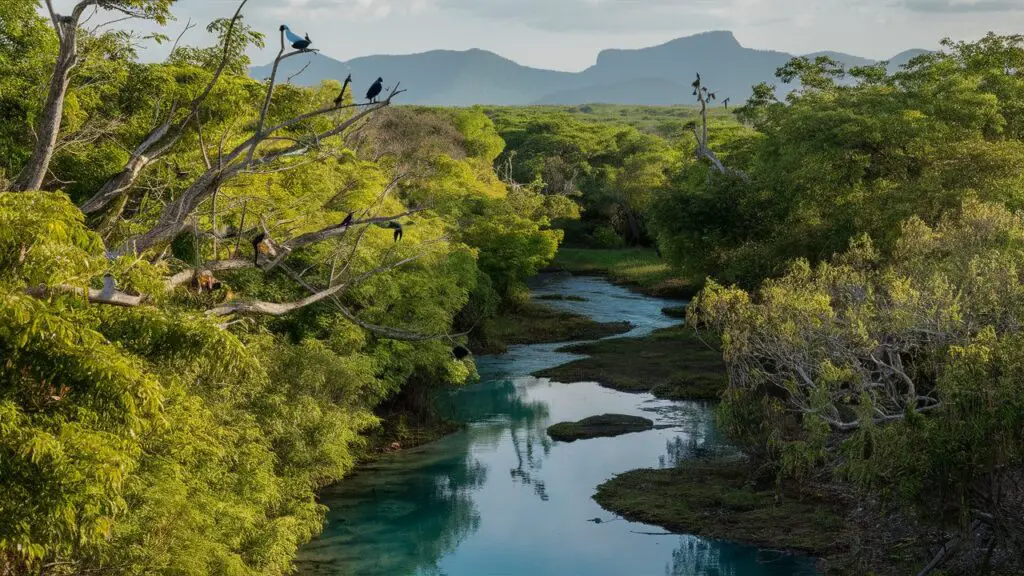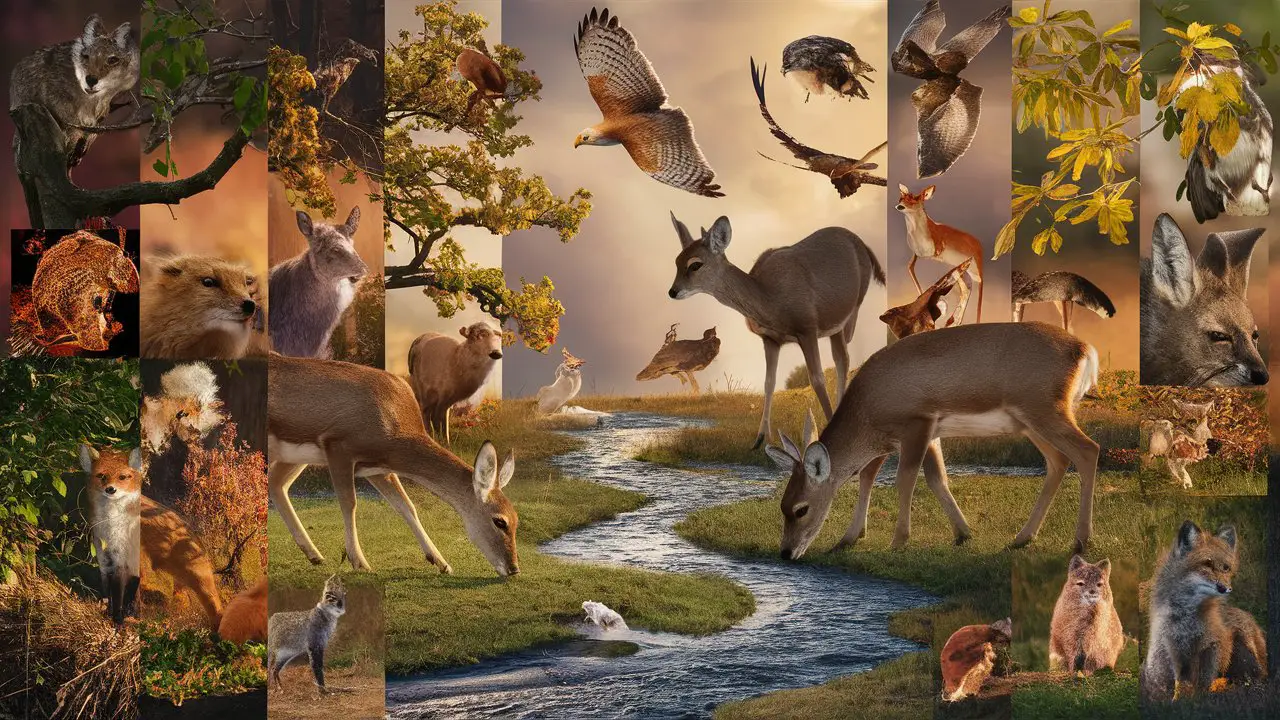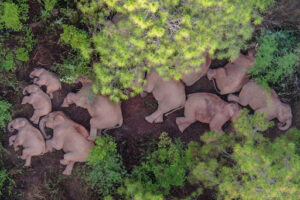You are about to embark on a fascinating journey into the complex dynamics of ecosystems. This comprehensive analysis will guide you through key concepts such as food webs, energy flow, trophic levels, and predator-prey relationships. You will gain critical insights into how nutrients cycle through ecosystems, the process of ecological succession, and the disproportionate impact of keystone species. The discussion of ecosystem resilience, stability, and fragmentation will shed light on how ecosystems withstand disturbances. In addition, you will deepen your understanding of ecological niches, biotic and abiotic factors, ecosystem services, decomposers, and ecosystem modeling techniques. The examination of human impacts, invasive species, seasonal variations, fire ecology, and ecosystem management practices will equip you with a holistic perspective. The article will also cover pressing issues like climate change and monitoring technologies. By the end, you will have a commanding grasp of ecosystem ecology to apply in your own work.
Understanding Ecosystem Dynamics
As an ecological system develops over time, you will observe changes in both the numbers and types of species present.
Succession
Succession refers to the gradual process of change in the species structure of an ecological community over time. Following a disturbance, a sequence of communities develop that are adapted to the changing environment. Over time, the available resources and habitat change, allowing new species to inhabit the area.
Biotic and Abiotic Factors
Ecosystems contain both living (biotic) and nonliving (abiotic) components that interact with each other. Biotic factors include plants, animals, fungi, bacteria, and all other living organisms. Abiotic factors refer to nonliving components such as sunlight, temperature, moisture, wind, soil, and nutrients. The interactions between biotic and abiotic factors help shape the ecosystem. Changes in either biotic or abiotic factors can lead to changes in the types of organisms in the ecosystem as well as in the flow of energy and cycling of nutrients.
Nutrient Cycling and Energy Flow
The living components of an ecosystem require a continual input of energy and nutrients to survive, grow, and reproduce. The primary source of energy for most ecosystems is sunlight. Nutrients, such as carbon, nitrogen, phosphorus, and many minerals, are cycled between the biotic and abiotic components of the ecosystem. Decomposers break down dead organic matter and release nutrients back to the soil and water, where they become available again to plants and other organisms.
Ecosystem Stability and Resilience
Ecosystems often appear stable and balanced over long periods of time. However, they are continually subjected to disturbances that can disrupt their stability. Resilience refers to the ability of an ecosystem to withstand disturbances and still maintain its basic structure and function. Ecosystems with high resilience are able to recover quickly from disruptions. Stability and resilience allow ecosystems to persist in the face of constant change.
Flow of Energy and Nutrients Through Food Webs
Producer and Consumer Levels
In any ecosystem, energy enters the food web at the producer level, which consists of autotrophs like plants that can synthesize their own food from inorganic substances using photosynthesis or chemosynthesis. The primary consumers, such as herbivores, then feed on the producers. Secondary consumers, the carnivores, feed on the primary consumers. Tertiary consumers feed on the secondary consumers. As you go up the food chain, there are fewer organisms at each level due to energy loss.
Energy Loss Between Trophic Levels
Energy is lost between each trophic level in the food chain due to factors like incomplete digestion, waste production, respiration, and heat loss. This limits the length of food chains and the number of trophic levels in a food web. Typically, only about 10% of the energy at one level is available to the next level. This loss of energy highlights the importance of producers like plants and algae at the base of the food web.
Cycling of Nutrients
While energy flows through an ecosystem, nutrients are recycled. Elements like carbon, nitrogen, and phosphorus are used over and over. For example, when organisms excrete waste or die, decomposers break them down and release inorganic nutrients back to the soil, air or water, where they become available to producers again. This cycling of nutrients, especially the activities of decomposers, is essential for sustainability in ecosystems.
In summary, ecosystems depend on the flow of energy and the cycling of nutrients to maintain themselves. Although energy is lost at each transfer between trophic levels, nutrients are recycled continuously through biological processes like decomposition. This highlights the interdependence of all components in a food web and the importance of each trophic level.
Predator-Prey Relationships Shape Ecosystems
The Influence of Predation
Predator-prey relationships are a key driver of ecosystem dynamics. Predators have a substantial influence over prey population sizes through direct mortality and by eliciting anti-predator behavior in prey that reduces their foraging and reproduction. For example, the presence of wolves in Yellowstone National Park has been shown to curb elk herbivory and allow willow and aspen stands to regenerate. By controlling prey numbers, predators also indirectly affect other species in the ecosystem that depend on those prey, highlighting the complex interdependencies in food webs.
Population Cycles
Predator and prey populations are often linked in oscillating cycles. As prey numbers increase due to abundant resources, predator populations also rise due to greater availability of food sources. The higher predation rate then causes a decline in prey, followed by a subsequent decrease in predators. This pattern continues, resulting in coupled predator-prey population cycles. For instance, the lynx and snowshoe hare populations in Northern Canada follow this cycle, with the lynx population rising and falling in response to changes in hare numbers over a 9-11 year period.
Co-Evolution and Adaptation
Predators and prey are also continually adapting to one another through co-evolution. Prey may develop defenses to deter predators, such as camouflage, warning coloration, or toxicity. Predators then evolve mechanisms to overcome these defenses, applying selective pressure on prey to adapt further. An example is the co-evolution of garter snakes and newts. Newts secrete tetrodotoxin as a defense, but some garter snakes have evolved resistance to this toxin, allowing them to prey on the newts. This evolutionary arms race has unfolded over time through the dynamic interplay between predation and adaptation.
In summary, predator-prey relationships are a pivotal factor influencing population dynamics, community structure, and evolutionary processes within ecosystems. By directly controlling population sizes and through complex interdependencies, these interactions shape natural systems from individual species to the level of the entire food web.
Ecological Niches Allow Species to Coexist
An ecological niche refers to the role and position a species occupies in an ecosystem. It encompasses how a species meets its needs for food and shelter, how it survives, and how it reproduces. Species that occupy different niches are able to coexist, as they do not directly compete for the same resources.###Habitat and Biological Niche The habitat of a species refers to the physical location where it lives, while its biological niche refers to its ecological role within that habitat. For example, two species of warblers may occupy the same forest habitat, but occupy different biological niches based on factors such as:
- Diet: One species eats primarily insects, while the other eats fruit and nectar.
- Foraging location: One species forages in the canopy, while the other forages in understory shrubs.
- Nesting location: One species nests in tree hollows, while the other builds nests in bushes.
These differences allow the species to exploit different resources and coexist in the same habitat.
Resource Partitioning
When species share a habitat, they employ strategies to partition resources and minimize competition in a process known as resource partitioning. This can involve differences in diet, timing of activity, location of foraging, and other factors. For example, several species of woodpeckers coexist by foraging on different parts of trees, eating different types of insects, and being active at different times.
Resource partitioning promotes diversity within ecological communities and ecosystem stability. When resources are limited, species that are better adapted to exploit certain niches will outcompete other species, eventually excluding them from the community. Maintaining diversity requires that resources be partitioned in a way that provides enough for the survival and reproduction of all species.
In summary, the ecological niche concept provides a framework for understanding how species coexist in communities and maintain diversity. By occupying separate niches based on differences in resource use, habitat, and other factors, species are able to exploit available resources without excessive competition. This promotes stability in ecosystems and allows for the coexistence of a greater number of species.
Biotic and Abiotic Factors Influence Ecosystems
The Living Components
The biotic factors in an ecosystem refer to all the living organisms, such as plants, animals, and microorganisms. These organisms interact with each other in a complex web of relationships that shape the structure and function of the ecosystem. The plants, as primary producers, absorb the sun’s energy and convert inorganic compounds into organic compounds usable by other organisms. Herbivores, the primary consumers, feed on the plants. Carnivores, the secondary consumers, prey on the herbivores. Omnivores feed on both plants and animals. Decomposers break down dead organic matter and release nutrients back to the environment.
The Nonliving Components
The abiotic factors refer to the nonliving physical and chemical elements in an ecosystem. These include factors such as sunlight, temperature, moisture, wind, soil chemistry, and availability of nutrients such as carbon and nitrogen. The abiotic factors influence which organisms can survive and reproduce in a location. For example, the amount of sunlight and temperature in an area will determine the types of plants that can photosynthesize and grow. The chemistry of the soil impacts which plants and microorganisms can thrive. The availability of nutrients constrains how much biomass the ecosystem can support. Changes in abiotic factors over time lead to ecological succession.
Interdependence of Biotic and Abiotic
Biotic and abiotic factors do not function independently; rather, they interact in complex ways to sustain the ecosystem. For example, the rate of decomposition by organisms depends on temperature and moisture. The availability of nutrients depends on the release of minerals from rocks through physical and chemical weathering. Climate influences the distribution of plants and animals. In turn, plants help regulate the climate by absorbing carbon dioxide and releasing oxygen through photosynthesis. This interdependence highlights how biotic and abiotic factors work in tandem to support the dynamic equilibrium in ecosystems. Changes to either can trigger ripple effects with consequences that are often hard to predict.
In summary, ecosystems emerge from the interaction of living and nonliving components. Biotic and abiotic factors are interdependent and help maintain the structure and functions that define ecosystems. An understanding of how these factors interact is key to managing ecosystems sustainably.

Human Impacts on Ecosystem Health and Stability
Habitat Destruction and Fragmentation
Humans have substantially altered natural habitats through activities such as deforestation, urbanization, and infrastructure development. The conversion of contiguous habitats into smaller, isolated fragments negatively impacts ecosystem health and stability. Habitat fragmentation leads to loss of biodiversity as species become isolated in small patches of suitable habitat. It also disrupts ecological processes like pollination and nutrient cycling across landscapes. Protecting existing habitats and restoring connectivity between fragments are crucial strategies for mitigating these destabilizing effects.
Pollution
Pollution from human activities like burning of fossil fuels, industrial processes, mining, and agriculture poses serious threats to ecosystem health. Various pollutants such as greenhouse gases, toxic chemicals, plastics, and excess nutrients can accumulate in the environment, harming plants and animals. For example, eutrophication caused by excess nitrogen and phosphorus leads to low oxygen levels and loss of aquatic life. Plastic pollution threatens wildlife through entanglement and ingestion. Pollution abatement and more sustainable practices are needed to curb these impacts.
Invasive Species
The introduction of invasive species, often facilitated by human activities, can have devastating consequences for ecosystems. Invasive plants and animals outcompete native species, disrupt ecological relationships, and alter ecosystem processes. For instance, zebra mussels introduced to North American lakes via ship ballast water have filtered out massive amounts of phytoplankton, disrupting aquatic food webs. Early detection of invasive species, restrictions on their transport and trade, and active control or eradication programs are critical for safeguarding ecosystem stability.
Climate Change
Human-caused climate change poses severe threats to ecosystems worldwide. Rising global temperatures are already altering ecological dynamics, as many species are shifting their ranges or the timing of key life events in response. Changes in precipitation and more frequent extreme weather events also stress ecosystems. If unchecked, climate change will continue to undermine ecosystem health and resilience through loss of biodiversity, spread of diseases, worsening wildfires, sea level rise, and other impacts. Urgent action is needed to curb greenhouse gas emissions and help ecosystems adapt to changes that can no longer be avoided.
In summary, human activities have substantially impacted the natural environment, disrupting ecosystem dynamics, reducing biodiversity, and threatening ecological resilience. Protecting remaining habitats, controlling pollution, managing invasive species, and mitigating climate change are critical steps toward safeguarding healthy, stable ecosystems into the future.
Managing and Restoring Degraded Ecosystems
Assessment and Monitoring
To properly manage and restore degraded ecosystems, comprehensive assessment and monitoring are required. Ecosystems should be evaluated to determine the degree of degradation and specific issues that need to be addressed. Continuous monitoring using technologies like remote sensing can help track ecosystem changes over time and the impacts of management practices.
Controlling Disturbances
Minimizing disturbances that negatively impact ecosystem structure and function is key. This may involve preventing overgrazing by livestock, limiting pollution from agricultural and industrial sources, and managing invasive species. Restricting access to sensitive areas can also help reduce damage from human recreational activities and trampling. Prescribed burning and other techniques may be useful for controlling the frequency and intensity of wildfires.
Reestablishing Native Species
Restoring native plant communities and wildlife populations are important for improving ecosystem health and resilience. This can involve reintroducing plants and animals that have been locally extirpated, as well as removing non-native species. Planting native vegetation and trees helps recreate habitat and food sources for wildlife. It also enhances soil quality and the water cycle.
Improving Connectivity
Fragmented ecosystems have limited connectivity, restricting the flow of organisms and nutrients. Establishing wildlife corridors and connecting existing habitat patches promotes recovery. This may involve acquiring land to link fragmented areas or negotiating conservation easements. Connectivity also facilitates seasonal migration and dispersal of plants and animals.
Sustainable Management Practices
To ensure the long-term viability of ecosystems, sustainable management practices should be implemented. This includes regulating human activities like development, transportation, and recreation to minimize further degradation. It also means using ecosystem management techniques that balance human needs with conservation. Promoting sustainable forestry, agriculture, and resource extraction can help support local economies while protecting the environment. With proper safeguards and oversight, ecosystems and human communities can thrive together.
Monitoring Ecosystems With Modern Technologies
Modern technologies provide powerful tools for monitoring ecosystem dynamics and health. Satellite imaging and remote sensing allow us to observe large-scale changes in ecosystems from space. These technologies can detect changes in vegetation, water levels, and other factors through analyzing the light reflected from the Earth’s surface. Ground-based sensor networks also provide localized, real-time data on abiotic conditions like temperature, humidity, and soil moisture.
Camera traps and audio recordings are useful for monitoring wildlife populations and biodiversity. Motion-activated cameras can capture images and videos of animals without human presence. By analyzing the frequency and patterns of wildlife detections, we can estimate population sizes and observe how species interact. Audio recordings enable us to monitor bird and insect activity by identifying species based on their calls and sounds.
Environmental DNA (eDNA) analysis involves collecting DNA from environmental samples like soil, water, and air to detect the presence of organisms. Even when a species is difficult to observe directly, traces of its DNA can indicate if it inhabits an ecosystem. eDNA is a non-invasive method for monitoring rare or elusive species. However, eDNA analysis requires extensive sequencing and analysis to distinguish between closely related species.
Ecosystem modeling uses computational simulations to represent complex dynamics between biotic and abiotic factors. Models incorporate data from monitoring technologies, experiments, and field observations to simulate how ecosystems respond to disturbances and environmental changes. Ecosystem models can explore the effects of hypothetical scenarios and management strategies when experimentation is unfeasible. However, the accuracy of models depends on the quality and quantity of data available to represent ecosystem complexity.
In summary, technological tools provide valuable data and insights for ecosystem monitoring, management, and conservation. Integrating multiple methods, from satellite imaging to eDNA sequencing, gives us a more complete understanding of ecosystem health and how it is impacted by human activities. Continually improving these technologies will enable sustainable management of ecosystems and the services they provide.
Ecosystem Dynamics FAQs
Ecosystems are complex systems comprised of interdependent biotic and abiotic components that interact through energy and nutrient flows. Several key concepts are fundamental to understanding ecosystem dynamics.
What are the levels of a food chain? Food chains depict the flow of energy through ecosystems, beginning with producers like plants that convert the sun’s energy into chemical energy usable by consumers. Primary consumers, such as herbivores, eat the producers. Secondary consumers eat the primary consumers. Tertiary consumers eat the secondary consumers. Each level depends on the level below it for energy and nutrients.
How do predator-prey relationships maintain ecosystem stability? Predators and prey exist in a dynamic equilibrium that helps regulate population sizes. When prey populations increase, predator populations also rise due to increased food availability. The larger predator population then hunts more prey, reducing prey numbers. Fewer prey lead to a decline in the predator population. This cycle continues, promoting stability.
What role do decomposers play in nutrient cycling? Decomposers, such as bacteria and fungi, break down dead organic matter and waste products, releasing the nutrients locked within them. The released inorganic nutrients, such as carbon, nitrogen, and phosphorus, are then available for uptake by plants and other producers, continuing the cycle. By making nutrients available for reuse, decomposers drive nutrient cycling in ecosystems.
How do ecosystems change over time? Ecosystems are constantly changing in a process known as ecological succession. Early successional communities are dominated by fast-growing plant species. Over time, the community composition changes as some species replace others. Late successional communities contain longer-lived, slower-growing species. Climax communities, the final stage, remain stable until disturbed. Succession progresses as organisms modify environmental conditions to favor their own survival.
What are some strategies for managing and restoring ecosystems? Ecosystem management aims to preserve ecosystem health and services. Strategies include: controlling pollution; limiting deforestation and habitat fragmentation; restoring degraded habitats; protecting biodiversity; removing invasive species; regulating human use and population growth; and mitigating and adapting to climate change. Careful monitoring of ecosystem dynamics and resilience can help determine the effectiveness of management practices.
Don’t Miss a Thing! Enhance Your Wildlife Photography with Ultra-X Night Vision Goggles.
GET NOW!






